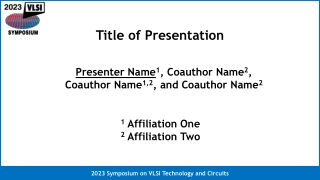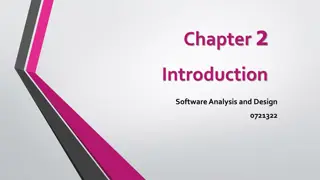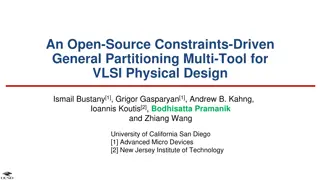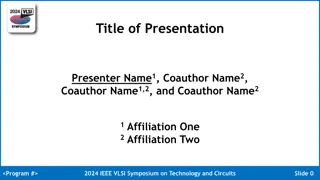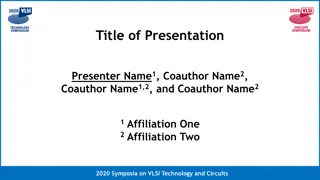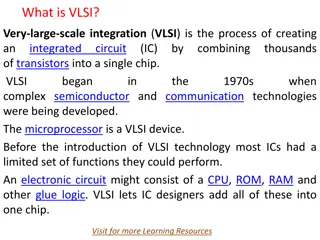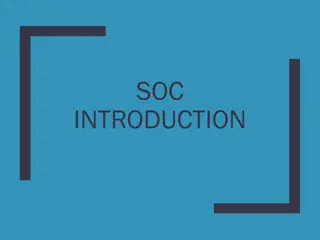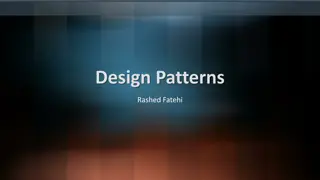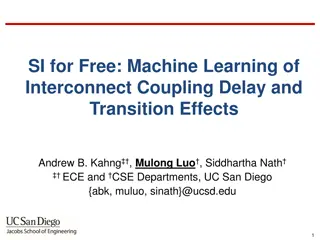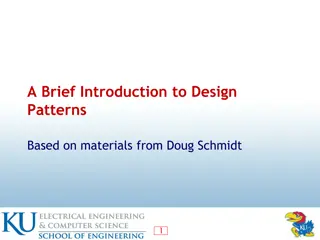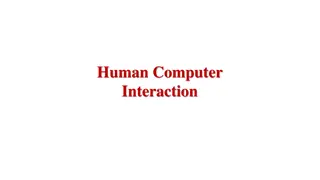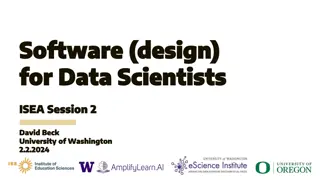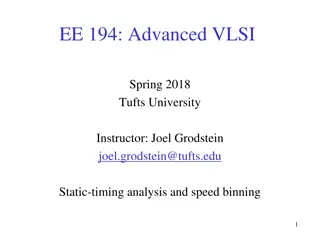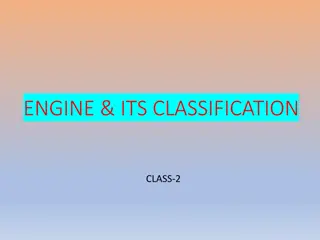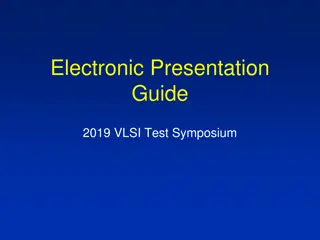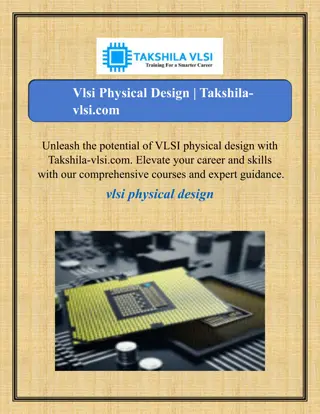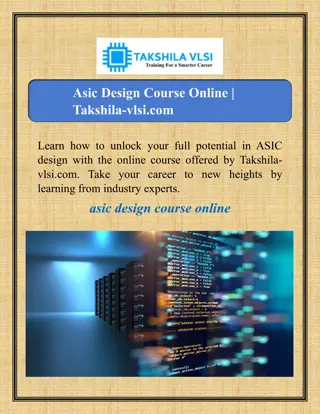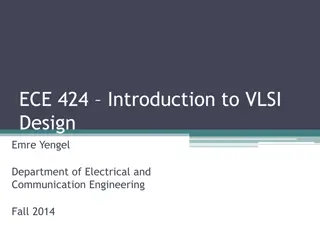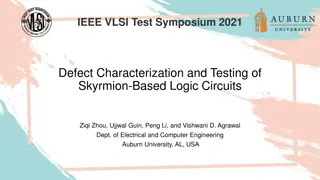Title of Presentation
Explore essential guidelines for creating impactful presentations in the field of VLSI Technology, covering slide format requirements, font size rules, and presentation flow tips. Ensure your presentation stands out at the 2023 Symposium on VLSI Technology and Circuits.
7 views • 23 slides
Software Analysis and Design Process
Software analysis and design involve a systematic approach to understanding user requirements, creating logical models, and transitioning to detailed design specifications. Requirements analysis focuses on capturing system requirements, while design translates these requirements into implementation
8 views • 16 slides
Open-Source General Partitioning Multi-Tool for VLSI Physical Design
An open-source tool called TritonPart offers a constraints-driven approach for general partitioning in VLSI physical design. It replaces hMETIS and is integrated with OpenROAD, providing features like multi-way partitioning and embedding-aware techniques. TritonPart shows significant improvements ov
4 views • 20 slides
Effective Presentation Guidelines for IEEE VLSI Symposium 2024
Create a successful presentation for the 2024 IEEE VLSI Symposium by following these guidelines: Format your slides to a widescreen layout with landscape orientation. Avoid corporate logos and use white backgrounds with dark text. Include presenter and coauthors' names, titles, and affiliations on t
2 views • 25 slides
Guidelines for Effective Presentations at 2020 VLSI Technology Symposium
Create impactful presentations for the 2020 VLSI Technology Symposium by following guidelines on slide format, font sizes, and content layout. Ensure your slides are concise, visually appealing, and focused on key concepts. Embrace simplicity, use simple diagrams, avoid complex equations, and rehear
2 views • 17 slides
VLSI Technology and Its Advantages
Very Large Scale Integration (VLSI) is the process of integrating hundreds of thousands of transistors onto a single microchip, revolutionizing the design and performance of electronic circuits. VLSI offers numerous advantages such as reduced circuit size, cost-effectiveness, increased operating spe
0 views • 15 slides
Online Vlsi Training Institutes In Hyderabad
Transform your career with the most exceptional online VLSI training from Takshila-vlsi.com, the premier institute in Hyderabad. Enrol now to unleash your full potential!
6 views • 1 slides
Guidelines for Design of Cement Concrete Pavement and Interlocking Paver Blocks
This document provides guidelines for designing cement concrete pavements and interlocking paver blocks, covering factors governing design, wheel loads, design period, subgrade characteristics, approximate k values based on CBR values, and the importance of a sub-base below concrete pavements. It em
0 views • 67 slides
Software Engineering Design Principles and Concepts
The chapter discusses the essential principles and concepts in software design, highlighting the four key design models - data design, architectural design, interface design, and component-level design. It emphasizes the importance of traceability to the analysis model, minimizing the gap between so
2 views • 36 slides
Dynamic Voltage and Frequency Scaling in Advanced VLSI
Explore the concepts of Dynamic Voltage and Frequency Scaling (DVFS) in Advanced VLSI design. Learn about the impact on clocking, STA, and testing, as well as considerations for selecting the right voltage and frequency settings. Discover how controlling voltage affects power consumption and computa
0 views • 51 slides
System on Chip (SoC) Design and Components
Explore the world of System on Chip (SoC) design, components, and working flow. Learn about Intellectual Properties (IP), platform-based design, typical design flows, top-down design approach, and the emerging Electronic System Level (ESL) design flow. Discover the essential components of an SoC, su
0 views • 45 slides
Design Inspiration and Elements in Costume and Fashion Design
Dive into the world of costume and fashion design through a visual journey of finding design inspiration, understanding the design process, emphasizing originality, and exploring different sources of creativity. Discover how technology, art, food, history, architecture, and nature can spark innovati
0 views • 45 slides
Enhancing Piping Design Efficiency with Spec-Driven Technology
Explore how Spec-Driven Piping technology powered by CADACTIVE offers a standardized approach for piping design in Creo Parametric. This innovative extension streamlines design communication, eliminates errors, and improves design efficiency by utilizing a master catalog, automated checking capabili
0 views • 15 slides
Material Design: Combining Classic Design Principles with Technological Innovation
Material Design is a design language that combines traditional design principles with the possibilities offered by technology and science. It emphasizes visual language, classic design elements, and innovation to create delightful user experiences. The Material Metaphor, Imagery, Typography, Color,
0 views • 34 slides
Comprehensive Guide to System Design Components and Techniques
System design involves the detailed planning and identification of components in an information system, aiming to provide users with a general understanding of the new system. This process includes techniques like flowcharts, prototyping, and component design, covering aspects such as output design,
0 views • 24 slides
Design Patterns: A Comprehensive Overview
Exploring the world of design patterns, this content delves into the essence of design patterns, their application in software design to resolve complexity, and the different types of design patterns - creational, structural, and behavioral. It also showcases examples of popular design patterns such
0 views • 22 slides
Introduction to VLSI CAD and Discrete-Event Simulation at Tufts University
This course introduces students to event-oriented simulation, building virtual models, and validating designs through simulation. It covers the importance of simulation in testing and refining designs before implementation. Examples include simulating VLSI networks and exploring the use of discrete-
0 views • 32 slides
Basic Concepts in Software Design
Software design involves transforming customer requirements into a form suitable for implementation, with activities categorized into preliminary and detailed design stages. High-level design focuses on module identification and control relationships, while detailed design entails defining data stru
1 views • 24 slides
Centre of Excellence in Signal Processing Activities and Progress Report
Broad areas of signal processing activities at the Centre of Excellence in Signal Processing include audio, speech, language, medical image processing, computer vision, wireless communications, and machine learning. The center focuses on addressing various challenges in audio/speech recognition, emo
0 views • 17 slides
Machine Learning of Interconnect Coupling Delay and Transition Effects
This research paper explores the use of machine learning to study interconnect coupling delay and transition effects in VLSI design. It discusses the challenges of calibrating non-SI to SI timing reports, the impact of clock period adjustments on path slack, and the complexities involved in the cali
0 views • 32 slides
Integrated Circuits: Fabrication and Packaging Technology
Integrated circuits are fabricated on silicon wafers using a photographic process. The resolution of this process determines the number of devices that can be integrated onto a single chip. After fabrication, the wafer is tested, diced, and functional die are packaged using aluminum or gold wires. T
1 views • 11 slides
Design Patterns in Object-Oriented Design
Design patterns in object-oriented design (OOD) are essential templates that codify best practices for solving common problems. They help streamline development by capturing proven design decisions, promoting code reuse, and enhancing system flexibility and modularity. Learn about the core concepts,
0 views • 20 slides
Interaction Design in Human-Computer Interaction
Interaction design focuses on creating interactive products that are easy, effective, and enjoyable to use. It aims to reduce negative user experiences while enhancing positive ones. Designing interactive products requires understanding user activities, interfaces, and device arrangements to support
0 views • 11 slides
SE2811 Software Component Design Overview
This course covers software component design, design patterns, object-oriented design, algorithms, and opportunities for reuse in systems design. It emphasizes the importance of domain-level design and provides insights into solving core problems through reusable classes.
1 views • 21 slides
Analysis of Bunch Lengthening in CEPC for Different Design Parameters
This study explores bunch lengthening in the Circular Electron Positron Collider (CEPC) for various design parameters, analyzing a 54 km design scheme, a 61 km design scheme, and a 100 km design scheme. The analysis includes the theoretical framework used, equations for bunch lengthening, and conclu
1 views • 15 slides
Plain & Reinforced Concrete Structures in Design Engineering
In the design of Plain & Reinforced Concrete structures, various strength design methods such as Ultimate Strength Design (USD) and Allowable Strength Design (ASD) are utilized. These methods involve factors of safety, material strength, load factors, and analysis in the elastic range. Additionally,
0 views • 11 slides
Verilog Adder Examples & Typical IC Design Flow
This comprehensive content delves into Verilog adder examples, typical IC design flow, physical design considerations, and examples of OpenGL ES GPU and ARM hypervisor applications. It covers the fundamentals of digital logic with Verilog design, hardware description language, FPGA prototyping, phys
1 views • 27 slides
High-Performance Gate Sizing with Signoff Timer: VLSI Design Challenges
This study delves into the intricate realm of gate sizing in VLSI design, focusing on optimizing power and delay through effective approaches and addressing challenges such as interconnect delay, inaccurate internal timers, and critical paths. Previous gate sizing techniques are evaluated, and a met
1 views • 34 slides
The Importance of Software Design for Data Scientists
Today's ISEA Session 2 with David Beck from the University of Washington delves into the critical role of intentional software design for data scientists. The session covers the software design approach, user-centric design stories, use cases, components, testing strategies, and the benefits and dra
1 views • 76 slides
Static Timing Analysis in Advanced VLSI Design
Static timing analysis is a crucial aspect of VLSI design, helping predict chip performance before fabrication. This article explores the importance of static timing analysis, its effectiveness, and the limitations of dynamic simulation tools like SPICE. Learn about the challenges in testing critica
0 views • 76 slides
Rectangular Dissections and Edge-Flip Chains in Lattice Triangulations
Explore equitable rectangular dissections and their applications in VLSI layout, graph mapping, and combinatorial problems in this scholarly work by Dana Randall from Georgia Institute of Technology. Discover the concept of partitioning an n x n lattice region into n2/a rectangles or areas where cor
0 views • 32 slides
Engine Classification and Design
Engine classification involves categorizing engines based on various factors such as combustion type, number of strokes, cylinder design, and ignition method. Common classifications include external and internal combustion engines, as well as categories based on the design and use of the engine. Add
0 views • 11 slides
Comprehensive Overview of Fault Modeling and Fault Simulation in VLSI
Explore the intricacies of fault modeling and fault simulation in VLSI design, covering topics such as testing philosophy, role of testing in VLSI, technology trends affecting testing, fault types, fault equivalence, dominance, collapsing, and simulation methods. Understand the importance of testing
0 views • 59 slides
Advanced VLSI - Dark Silicon and Power Management Challenges
Explore the complexities of VLSI design including the concept of dark silicon and the challenges of power management in modern microprocessors. Delve into strategies such as conditional clocking and DVFS to address these issues in the ever-evolving field of semiconductor technology.
0 views • 17 slides
Effective Electronic Presentation Guidelines for VLSI Test Symposium
Comprehensive guide for creating impactful electronic presentations at the 2019 VLSI Test Symposium. Covers presentation specifications, best practices, and tips to engage a technical expert audience effectively. Emphasizes concise content, visual clarity, high contrast, limited text, and smooth tra
0 views • 17 slides
vlsi physical design
Unleash the potential of VLSI physical design with Takshila-vlsi.com. Elevate your career and skills with our comprehensive courses and expert guidance.\n\n\/\/ \/product\/physical-design\/
2 views • 1 slides
asic design course online
Learn how to unlock your full potential in ASIC design with the online course offered by Takshila-vlsi.com. Take your career to new heights by learning from industry experts.\n\n\/\/ \/product\/asic-verification\/
3 views • 1 slides
Stick Diagrams in VLSI Circuit Design
Stick diagrams in VLSI design help visualize the layout of components on silicon by capturing topography and layer information through color codes or monochrome encoding. They serve as an interface between symbolic circuits and actual layouts, facilitating the planning of layout and routing while de
0 views • 27 slides
VLSI Design Methodologies and Layout Rules: A Comprehensive Overview
This detailed content provides an in-depth exploration of VLSI design methodologies and layout rules, focusing on topics such as standard cell layout methodology, transistor dimensions, design rules for n-well process, and more. The information covers important aspects like minimum widths, spacings,
0 views • 35 slides
Defect Characterization and Testing of Skyrmion-Based Logic Circuits at IEEE VLSI Test Symposium 2021
With CMOS devices nearing quantum-mechanical limits, magnetic skyrmions offer a promising solution for next-generation spintronic logic devices and memories. This presentation at the IEEE VLSI Test Symposium 2021 delves into defect characterization and testing of skyrmion-based logic circuits. It co
0 views • 19 slides
